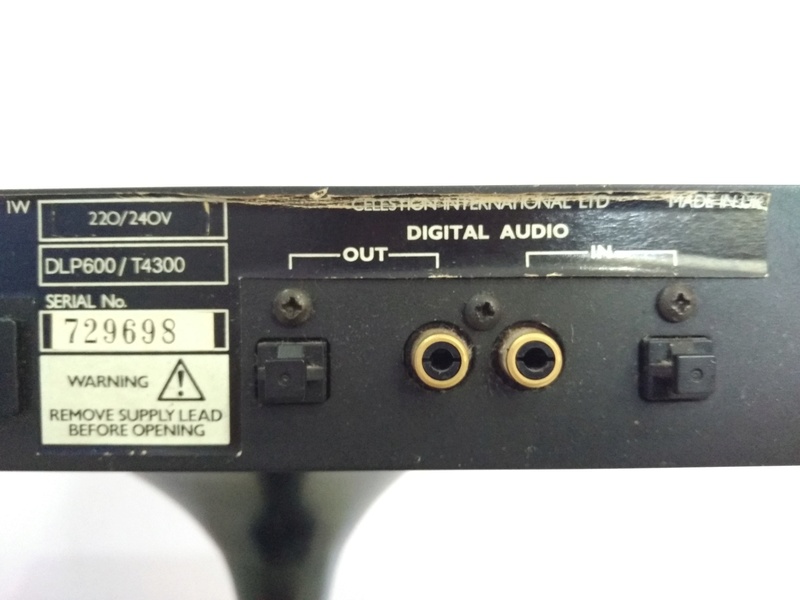Celestion DLP 600 Digital Processor Equalizer for Celestion SL-600 Speaker
Hi-Fi 4 Sale - Malaysia / Singapore Audio Forum & Marketplace | www.hifi4sale.net :: Audio & Video Equipment Marketplace :: Audio & Video Equipment: FOR SALE (Pre-owned & Used)
Page 1 of 1
 Celestion DLP 600 Digital Processor Equalizer for Celestion SL-600 Speaker
Celestion DLP 600 Digital Processor Equalizer for Celestion SL-600 Speaker





Made In UK
"The Implementation of a Digital Loudspeaker Processor for the Celestion SL600/SL600Si
DLP600
Celestion's DLP600 is a small, rectangular black box that accepts a digital data input from a CD transport or DAT machine and outputs a manipulated digital data stream that can be fed to a D/A processor. The correction applied is specific to one loudspeaker, Celestion's SL600Si. There are two data inputs, one Toslink optical, the other coaxial, the former having priority. (The input automatically switches to the optical unless a digital signal is present at the coaxial input.) There are also two data outputs, again one Toslink optical and the other coaxial. Front-panel LEDs indicate Power On, Data Lock, and Equalization In/Out, the last controlled by a front-panel pushbutton. The equalization is only applied to data sampled at 44.1kHz. While 32kHz and 48kHz data are accepted, the equalization is disabled.
Internally, the DLP600's circuitry is laid out on a single printed circuit board. The input data are received by the ubiquitous 16-bit Yamaha YM3623B digital audio decoder IC and fed to a DSP (Digital Signal Processor) IC. This is an Analog Devices ADSP-2105, a chip said to be well-suited to being used as an FIR (Finite Impulse Response) digital filter due to an efficient instruction set.
Two families of digital filters are realizable with such a DSP chip: FIR and Infinite Impulse Response (IIR) types. An FIR filter, which in the real world of limited hardware resources is best suited to high-frequency processing, basically multiplies each input data sample by each of a set of coefficients (numbers) in turn, the output being the sum of the results of each operation. By contrast, though an IIR filter uses similar multiplying and adding operations on the audio data, it feeds some of the output back to its intermediate stages. The IIR type is theoretically more versatile, therefore, and can be used to process lower frequencies than an FIR type, but is both more complex to implement and design for an arbitrary response shape, and runs the risk of instability under some conditions. The FIR type, however, can produce complicated response shapes as easily as it can classical low-, band-, and high-pass filters.
As Celestion's engineers decided only to apply correction above 1kHz, leaving the speaker's low-frequency rolloff alone, they were able to implement the filter for the SL600Si as an intrinsically stable FIR type. They also decided to accept the fact that there would be some time delay in the process which could not be compensated for; the target response for the speaker would therefore be "linear-phase"; ie, the phase increasingly departs from zero with frequency in a linear manner.
The 81 coefficients for the DLP600's FIR filter are held in an EPROM and are loaded into the DSP engine on power-up. The EPROM also holds a set of coefficients representing no equalization. These are also loaded into the DSP; pressing the EQ In/Out button actually chooses between the two sets of filter coefficients, the DSP operating on the signal in both conditions.
As there are 81 coefficients operating at a sampling rate of 44.1kHz, this means that the impulse response of the DLP600's FIR filter can be 81 x 22µs long: 1.83ms, which should be enough to compensate for early reflections of the sound. To determine what these coefficients should be, the SL600Si's impulse response is measured at a distance of 2m. The axis chosen (although I didn't know this until I had performed all my measurements) was 10 degrees laterally off the listening axis. This impulse response is transformed to the frequency domain with the Fast Fourier Transform, and the inverse response above the minimum frequency of interest calculated. Performing an inverse FFT and time-windowing the result gives the impulse response of the desired filter, from which the coefficients can be derived. These are loaded into the DSP and the resultant speaker response auditioned, at which time the designer decides whether the result is better or not. If not, it's time to reconsider the choice of target response.
Because the Fourier Transform implicitly assumes a perfectly linear system, the loudspeaker must not add distortion in the frequency range of interest. In addition, it must not have deep notches in its response, nor must it significantly roll off below 22kHz. These last factors would demand large boosts in the correction EQ which will compromise the overall performance.
After processing by the ADSP-2105, the data are re-encoded with quite a large amount of high-speed TTL logic chips and connected to the DLP's output socket via a pulse transformer. There is therefore no electrical ground connection between the DLP600 and the user's D/A processor, even if the coaxial feed is used.
Celestion's original SL600 minimonitor of 1983 was a ground-breaking design in that its cabinet used 0.5"-thick Aerolam, an aluminum-honeycomb material extensively used in the aerospace industry. This is effectively inert in the midrange—see Stereophile, Vol.15 No.6, June 1992, pp.206-207—and results in a superbly transparent presentation from its 32mm, electroformed copper-dome tweeter and 6.5" woofer. A revised version, the SL600Si, was released in 1988, differing from the older model in having two sets of 4mm input sockets—two for the HF leg of the crossover and two for the bass/midrange—to allow bi-wiring or bi-amping, and a revised layout for second-order, 12dB/octave crossover with star-grounding.
The DLP600 does demonstrate, however, how an already excellent speaker can be made even better
Like Coffee Added Coffee MATE
Celestion DLP600:
stereo digital filter/time-domain equalizer that fits between an S/PDIF, 44.1kHz digital data source and a D/A processor (32kHz and 48kHz data are accepted, but equalization is disabled).
Data inputs:
one optical (Toslink),
one coaxial (gold-plated RCA jack);
16-bit-capable only.
Data outputs:
one optical (Toslink),
one coaxial (gold-plated RCA jack).
Front-panel controls:
equalization in/out.
Indicators: Power On, Data Lock, Equalization In/Out.
Dimensions: 7.75" (240mm) W by 1.75" (44mm) H by 9.25" (182mm) D.
Weight: 2.5 lbs (1.15kg).
Note : Can Use With Others Speaker for sound improvement
Price : RM 850
Contact Simon Ting 012-3612507
HiFiLab- Dealer\Reseller\Trader\Service Provider

- Number of posts : 2971
Age : 45
Location : klang
Registration date : 2011-03-12
Character sheet
Source(s):
Amplification:
Speakers:
 Similar topics
Similar topics» Nikkodo Digital Echo Processor DEP-2000K with Digital Key Controller Karaoke (Sold)
» Nikkodo Digital Echo Processor DEP-2000K With Digital Key Controller Karaoke(sold)
» BMB Digital Echo Processor With Digital Key Controller DEP-1500k
» PS Audio SL Three Digital Processor DAC (Used) SOLD
» Marantz Digital Processor (Used)
» Nikkodo Digital Echo Processor DEP-2000K With Digital Key Controller Karaoke(sold)
» BMB Digital Echo Processor With Digital Key Controller DEP-1500k
» PS Audio SL Three Digital Processor DAC (Used) SOLD
» Marantz Digital Processor (Used)
Hi-Fi 4 Sale - Malaysia / Singapore Audio Forum & Marketplace | www.hifi4sale.net :: Audio & Video Equipment Marketplace :: Audio & Video Equipment: FOR SALE (Pre-owned & Used)
Page 1 of 1
Permissions in this forum:
You cannot reply to topics in this forum








